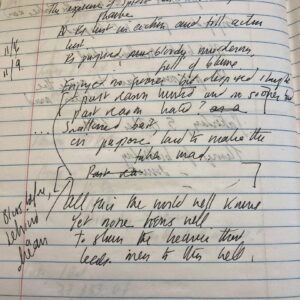The other day I was browsing in an anthology of modern poets, and I came across this beautifully austere poem by Wallace Stevens from his first book, Harmonium, 1923:
The Death of a Soldier Life contracts and death is expected, As in a season of autumn. The soldier falls. He does not become a three-days personage, Imposing his separation, Calling for pomp. Death is absolute and without memorial, As in a season of autumn, When the wind stops, When the wind stops and, over the heavens, The clouds go, nevertheless, In their direction.
As I thought about this poem, I recalled a back and forth with my late colleague David Ferry, whom I came to know at Wellesley College, where I began teaching in the English Department in the mid-1970s. Some thirty years older than me, David had written an important monograph on Wordsworth and had edited other books; and, during the decades I knew him, he became a major poet as well, highly praised and honored for Bewilderment: New Poems and Translations (2012), and for translations of the Epic of Gilgamesh, Horace, and Virgil.
I valued David as a friend and mentor, a gifted teacher, firm and forceful, caring and kind. He had formidable authority, and I was both drawn to him and apprehensive, worried I might make a judgment that he would not approve of. David had great insight into and sensitivity about literature, and an assurance and wisdom about teaching that I aspired to.
My four years in graduate school had been stimulating in intellectual terms, much of this linked to the excitement about literary theory—Barthes, Derrida, Foucault. But not a word was said to us, the graduate students, about teaching. As section leaders, we corrected exams and papers. But planning a course, shaping a syllabus, everything we would be doing if we were fortunate enough to get a job: we were on our own, no advice or support.
I was grateful that David reached out before I arrived, writing letters to me about the courses he knew I had been assigned. In one of my replies, I said with youthful pomposity that I thought it was essential for students to learn about history, about poems in their historical contexts.
David said he agreed. But he went on to explain that he was more interested in the history that’s in the poem itself. He was addressing me as an equal, but then again not quite. David wasn’t saying I was wrong. He was communicating to me that there was another way to think about a poem, its organization as a work of art.
“The Death of a Soldier” was written a few years after World War I, and scholars have commented on Stevens’s responses to the war and to his reading of Lettres d’un soldat, 1917, by a young French painter-soldier, Eugène Lemercier, killed in northeastern France in April 1915. This is worth knowing about, and in the classroom we could bring it to the attention of students. But in his letter, David was encouraging me to realize that there are other forms of history, of historical thinking, that poets articulate and explore in the configuration and operation of the language.
David studied and probed each poet’s words, noting details, asking questions about them, keeping his students focused and vigilant, pointing to a surprise, a turn in syntax, an implication in an image overlooked first time through. I never heard him speak about “The Death of a Soldier,” but I imagine he would have discussed the brevity of the poem in relation to the large solemnity of the title, the short lines, the choice of a four-stanza structure, the relation of each stanza to the next, even the punctuation—for instance, the periods marking the two sentences in stanza one, the period completing stanza two, and the comma extending the third stanza into the fourth.
Stevens moves from “Death” in the title to “Life” as the first word, and then back to “death.” Death/Life/death, so near to one another, as though the transition from one stage to the next happens almost concurrently. The tone is hard to hear, it’s nearly a toneless tone, not the resonance of language emerging from a flesh and blood speaker.
We do see signs of Stevens’s creative hand, in, for example, the double meaning of “contracts” in the opening line: 1) as of a muscle, to become shorter and tighter to effect movement of part of the body, and 2) to enter into formal and legally binding agreement. It’s as if life has made a contract with death. “Is expected”: passive voice, no indication of who or what has this expectation.
“Autumn” typically carries associations of the harvest, sometimes exuberant, but, more often, grim reaping, life waning, and the present tense verb “falls” makes quiet play with “autumn.” The word “fall” in a poem inevitably calls to mind, too, Adam and Eve and the loss of Eden. But it isn’t clear that Stevens intends for us to make such a connection. The same could be said about “three-days.” Is he alluding to Christ’s passion, death, resurrection? And there’s “heavens” later. The poem allows us to conceive of religious references that it might be glancing at, yet that it is withholding, not making explicit.
Line 8 repeats the phrasing of line 2, just as line 10 repeats line 9. I hear the interplay of syllables, a few words multisyllabic amid mostly plain one-syllable words. “Personage” is a term used to express someone’s significance, importance, or elevated status. That’s an eminence that the soldier does not seek, nor is it bestowed on him. He does not, he cannot, act. In death, he does not become, impose, or call.
The third stanza, line 1, “Death is absolute and without memorial,” is simple, poised, cool, almost cold, without affect. The speaker makes no argument, offers no explanation: this is the assertion, and there is no disputing it. We are not given space or opportunity to think otherwise about the absoluteness of death and the impossibility of commemorating it, including in this poem or any other. The soldier has disappeared. Stevens closes with the paradox of clouds advancing in windless skies.
We could introduce information about history and biography when we read and respond to “The Death of a Soldier.” Yet as I ponder the mood and movement of its lines, this feels intrusive to me, not something that the poem is soliciting us to supply. Stevens wants us to experience it internally, not in conjunction with his reading or with the agonizing particulars of World War I. He excludes all of this, designing instead an abstract form of statement and reflection that is at once tragic and serene.
The imprint of my friend David Ferry’s words leads me to say that “The Death of a Soldier” is a poem about history that has no specific history connected to it. Stevens is asking us to think about what history is as an idea, a totality, the history that both unites and transcends immediate and local histories. He evokes the death in war of a single soldier who represents countless others—their names and identities, and the causes for which they fought, lost in time, unremembered.
William E. Cain is Mary Jewett Gaiser Professor of English at Wellesley College, where he enjoys teaching courses on Ralph Waldo Emerson, Henry David Thoreau, and other American writers. His recent publications include essays on Edith Wharton and Ernest Hemingway.





